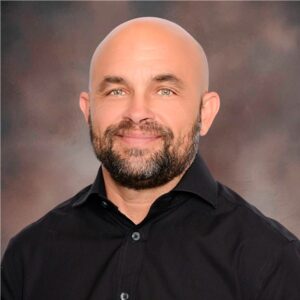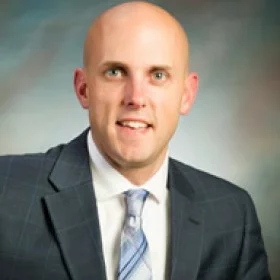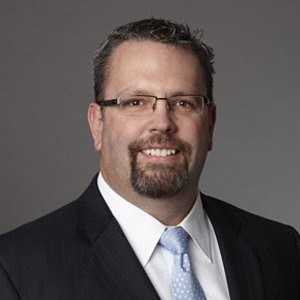Picture the scenario: an organization is in the midst of a rapid expansion plan while also taking steps toward digital transformation. To ensure growth happens in a sustainable way, more talent must be hired – unfortunately, the talent pipeline seems to have dried up.
Not exactly a unique situation in today’s healthcare landscape. What is unique, however, is the approach that Eisenhower Health has taken to address this issue. Their answer, according to CIO Ken Buechele, was to construct a new pipeline by establishing an IT apprenticeship program.
“The landscape of the technology skillset and the market in our community has changed,” he said during a recent interview with This Week Health. In addition to a 437-bed hospital, Eisenhower offers dozens of outpatient locations scattered throughout the Coachella Valley region of Southeastern California. Although the area, which is “somewhat isolated” due to nearby mountain ranges,” has never had a problem attracting visitors, filling onsite IT positions started to become increasingly challenging in the post-Covid world. “We need to think about how to grow and retain talent in a way that allows us to meet the organization’s needs.”

Ken Buechele
Compounding the issue is the fact that Eisenhower has “all of the world class tools you’d find in larger institutions,” Buechele noted. “We’re doing everything that most of the bigger players are doing; we’re just doing it on a much smaller scale” – and with fewer FTEs.
That’s where the apprenticeship came into play. Shortly after taking on the CIO role in January 2022, Buechele started to implement an initiative that could not only help fill key positions, but strengthen the entire workforce.
“It’s basically an internship on steroids,” he said. “They start with us in the summer and work full-time. But instead of going back to school after three months, we expect them to stay on part-time.” Most interns continue to work 1 or 2 days per week, and some have remained on for as long as three years.
As part of the program, individuals rotate through departments, which helps them gain exposure to different tasks. That, he noted, “gives them not only just the baseline of the complexity of the IT aspects, but also an orientation to Eisenhower as an organization. It’s important, regardless of where you are, to get a sense of the calls that we get, the technologies that are used, and what happens in that role.” For example, calls that come from the ED or OR need to be prioritized. “These are the customer service skills that make a good service desk technician.”
Like many CIOs, he believes those skills are best learned onsite – the problem is that potential hires don’t feel the same way.
“Before Covid, we would see people with 3, 4 and 5 years of healthcare IT experience applying even for entry-level roles,” said Buechele. Now, “we’re really struggling to align helpdesk and network technician-type roles with locals.”
As a result, Buechele’s team had to restructure job descriptions and reset expectations by targeting a completely new audience. Instead of trying to squeeze more out of a shallow pool of applicants, Eisenhower partnered with local colleges and high schools to identify possibilities for partnerships.
What they learned was quite interesting: the technical education curriculum in high school has grown by leaps and bounds in recent years.
Whereas years ago “it was woodshop classes,” now, it’s a different world. “They’re basically getting their security-plus by the time they’re out of high school,” Buechele said. “And so, there’s an amazing opportunity to capture students right out of high school and introduce them to our program.”
The other compelling learning? Colleges are behind the eight-ball when it comes to career preparation. “We get a lot of applications from recent grads that don’t have any hands-on experience,” he noted. The apprentice program has “helped build the skills and the talent that we’re looking for.”
Importantly, it goes “beyond the nuts and bolts of how to image a computer and replace equipment, and how to be a desktop technician,” he added. By having trainees go through various rotations, “They get a better sense of who we are as an organization.”
And it’s not limited to desktop help – although that is critical. “We’re creating security analysts, network engineers, telecom engineers and ultimately, Epic analytics,” he said, adding that Eisenhower also plans to offer help with classes and certifications. “That’s the skin we’re putting into this. The goal isn’t just to fill seats.”
As with any initiative, a critical factor in determining success is ensuring the right pieces are in place, starting from the top. Although supervisors have been appointed to provide guidance, apprentices report to Buechele, whose team then facilitates the onboarding process. “I make it a point to be part of the process and make sure everyone understands how important it is,” he said, which helps ensure the program doesn’t “fall by the wayside” when things get busy.
“You have to continue to nurture it,” noted Buechele, who emphasized the value of both executive support and departmental champions. “The key is to find somebody who will take it on as a passion project and believe in it.”
It’s also important to note that the onboarding process will likely differ substantially with apprentices. “They may have to shadow and observe longer than those with previous experience,” he said. And while that might take more time, it’s important to ensure individuals are developing skills, and not just taking on tasks that others don’t want. “Every organization has projects like Windows 11 upgrades or lifecycle replacements that are the right mix of task and repetitive work, but we also have things that are meaningful from a knowledge and growth perspective,” Buechele noted.
“That’s one of the things that I've stressed with my team: I don’t want them just doing spreadsheets and cleanup work,” or in a desktop context, wiping hard drives. “I want them to learn, and they can’t do that if they’re just imaging computers all day or pressing buttons all day. We try to make it meaningful.”
What they’re not trying to do is expand too quickly. The program has had about 3 participants each year, about a third of whom have been hired full-time. And while it’s not making waves on a national scale, Buechele believes it has the potential to become a game-changer, particularly for organizations that aren’t partnered with large universities.
“We need to find a way to capture what colleges and high schools are doing right and provide experience in a way that’s meaningful,” he noted. Through their innovative program, Eisenhower has found a way to “source talent in the community.” And it’s a method that can work across the board, as long as organizations are willing to put in the work to develop partnerships, establish a solid foundation, and invest in people.
There’s no shortage of challenges facing healthcare CIOs, particularly in the current landscape. But perhaps the most significant, according to Brian Lancaster, is a lack of comprehension – not of the technology itself, but rather, everything required to make it work.
“People need and want technology, but they don’t know the cost. They don’t know the cybersecurity risks. They don’t know what a major incident looks like,” he said. “It’s our burden as leaders and technologists to make sure they understand all those factors, and at the end of the day, empower them.”

Brian Lancaster
That’s where the CIO comes in, according to Lancaster, who took on the role at Children’s Mercy Kansas City in 2022. In addition to guiding the IT strategy, leaders must be able to build and maintain relationships, instill confidence in teams, and create momentum for major initiatives – which is precisely what Lancaster is doing as he prepares to lead a migration from Cerner to Epic’s EHR.
In fact, that opportunity is what attracted him to Children’s Mercy, and it was his unique background – which includes 17 years with Cerner, largely in product management, as well as more than 7 years as CIO at Nebraska Medicine – that helped land him the position.
“I thought it would be beneficial from a career standpoint to have pretty deep vendor expertise with Cerner and then start to learn the provider side in an Epic shop,” he noted. Indeed, that experience set him apart during the recruitment process at Children’s Mercy, as the organization ultimately chose Epic, and relied on Lancaster to lead the migration.
As Children’s progresses toward its go-live, scheduled for March 2026, he shared some of the lessons learned and offered best practices for leading teams through periods of dramatic change.
When organizations transition to Epic – which has become a common trend in recent years – the onus often falls on CIOs not just to help sell it to the board, but also to the staff. One way to do that? By educating teams on the benefits of Epic – and of adopting its doctrine.
Because while that strategy of “here are our standards, here is your grade against those standards” may seem rigid, he believes it’s necessary. “It creates a better implementation and a stronger foundation for innovation,” Lancaster noted. “You can do new things because the basics are in place and that comes from a combination of technology, but also people and processes.”
Part of that philosophy is ensuring that individuals from a variety of areas, including informatics, business, and clinical, among others, are actively engaged in the process. “That’s the way it should work in healthcare – we should understand what their needs are and provide solutions to them. We should not be doing technology to them,” he said. “It’s a fundamental difference in how Epic operates. They get operations and clinicians engaged, and that helps with buy-in.”
Where it can get “sticky” with Epic, however, is when a suggested practice doesn’t work. In these cases, teams need to be able to ask questions. “We beat this drum that we’re going to follow Epic’s Foundation and leverage what our friends at places like Boston Children’s are doing,” Lancaster said. As a result, “our team wasn’t feeling empowered to say, ‘that’s strange. Maybe we shouldn’t do it that way.’ We have to strike a balance.”
That, interestingly, was one of the most critical lessons he learned. “It wasn’t necessarily how to run a work group or how to make the operational decisions we need to make; it was empowering the team to push back.”
And not in an aggressive way, but in a way that generates a productive conversation, while also helping analysts and informaticists develop new skillsets that will pay dividends in the future. “It’s helping us adopt some modern approaches in how we think about technology and how we continue to empower the frontlines,” he added.
With an implementation of this magnitude, it can be easy to focus mainly on the clinical and business aspects, but it also creates an opportunity to transform the infrastructure, which is part of Lancaster’s vision.
In parallel to the EMR modernization effort, Children’s is also developing a more robust data archive and conversation strategy that he believes will yield benefits in the future. “The consistent thing across any healthcare IT department, whether it’s an academic medical center or a children’s hospital, is that people want and need new technology to continue to be relevant. So how do you automate and consolidate to meet those demands?” By modernizing the infrastructure, organizations can “set the stage for a solid foundation to meet all of those demands,” he noted.
As part of that strategy of thinking ahead, his team is deliberately considering platforms that have built-in AI capabilities. “Our current plan is to have a selected ambient documentation vendor at go-live and do a pilot and enterprise rollout as a fast-follow so that we can stage it appropriately,” he said. “One of the compelling parts of Epic is all of the options they have for AI – both what they’re building as well as integrations with partners.”
Introducing ambient tools, however, represents a significant change in the workflow, as do other major initiatives like EHR migrations. CIOs, therefore, need to invest time and energy into creating “meaningful relationships.” And that, according to Lancaster, entails “spending time listening to peers and understanding them so that you can build the foundation to inform them of decisions that need to be made.”
That also means being bold enough to speak up when something doesn’t seem right – or when, for example, a leader is being influenced by a vendor to make a recommendation. “You need to have the confidence and the knowledge to go to them and explain, ‘I know why you want to do system X, but that will create this type of outcome. I think we could also get those outcomes by using this system we already have,’” he explained. “Walk through it from a business case standpoint, but in a very simple manner where it’s time, effort, outcome based.”
Having these types of uncomfortable conversations, Lancaster said, can play an enormous role in helping leaders shift from being an order take to a strategic partner.
Another aspect in that shift comes in how leaders measure key performance indicators. For example, an order taker will focus primarily on turnaround times, satisfaction scores, and availability, while strategic partners ask questions such as, ‘how do I transition to be value-based? How do we enable growth? How do we increase physician satisfaction? By doing so, “we’re creating value for the organization through technology,” he said. “That, to me, is an awesome aspect of change management.”
On the other hand, one of the more difficult aspects is ensuring the message not only reaches the intended audience, but sinks in. Sometimes it’s as simple as getting what he calls the ‘wait… what?’ response, which happens once individuals have had a chance to absorb the information.
“If you don’t hear that ‘wait… what?’ chances are you’re not going to get adoption. You have to keep communicating and make sure it’s clear,” he said. “Now they get it and understand why we’re no longer allowing you to use personal email, or why we can’t buy a system. And then, you get alignment.”
It’s one of the harsh realities of the CIO role, according to Lancaster. “Sometimes we’re there to enable opportunities and strategy. We're using technology to do something amazing,” he said, citing ambient documentation as an example. “But sometimes it’s explaining that we can’t do that because of the cybersecurity concern, or that you now have to use multi-factor authentication.”
The key is in finding the right way to communicate with different teams and individuals, he noted, citing advice he received years ago from a mentor to “consult like the CEO,” which entails laying out the options and cataloging the pros and cons. “It’s saying, ‘I strongly recommend option A. You can do option B and C, but anticipate that we’re going to have to hire a team, or we won’t get the results.’ And make sure they understand it.”
Another way to think about it? “You can’t cross a 10-foot chasm with two 5-feet jumps,” Lancaster said. “You have to have the ability to jump the whole chasm, or you’re going to break a leg.”
Governance.
No one wants to talk about it, and yet, it’s one of the top priorities on everyone’s list. The question is, why?
Part of the reason, according to Luke Olenoski, SVP and CIO at Main Line Health, is the negative connotation associated with the word itself.
“Governance has a rigid feel,” he said, likening it to “a meeting where things get a ‘yes’ or a ‘no.’ We’re really talking about an operating model of how we interact with our stakeholders,” he noted. One that “signifies an end-to-end process,” rather than an isolated project, and “represents a more dynamic relationship” among various departments.
Chris Walden, VP of IT at Tenet Healthcare, agreed, noting that governance can become “overly bureaucratic,” which is particularly problematic due to the common associate with IT. At the 49-hospital, multi-state organization, “There’s no such thing as IT governance. It’s operational governance,” he said. Doing so clarifies that decisions are made to align with organizational goals rather than meeting departmental needs.

Chris Walden
And while terminology is important, what’s even more critical is having a solid framework in place to evaluate, prioritize, plan, and execute projects. Recently, Walden and Olenoski spoke about the benefits of governance programs, and shared valuable insights on how to successfully implement them.
As health systems face a growing list of demands, it’s becoming increasingly challenging for leaders to prioritize tasks. That, noted Walden, is where governance comes into play. “We needed a way to be able to funnel those things in and determine which have the strongest business case and which fall under the category of ‘keeping the lights on’ so that people knew which path to take.”
And in fact, he believes a strong governance strategy can help teams by setting parameters. “Without it, how do your customers know, what do I do? What shouldn’t I do? Who’s helping me?” he said. Reframing the conversation can shift some of the burden away from IT while educating and empowering others.
It also provides teams with “a broader view of what’s going on” throughout the organization, and ensures diverse representation in the decision-making process. “By having a governance group that’s coming at it from different lenses, we’re able to get that collective agreement,” Walden noted.
So what, exactly, does the ideal governance model look like? While there isn’t a one-size-fits-all approach, there are best practices that can be adopted regardless of the size of an organization.
“It truly does take a village,” Walden noted, adding that at Tenet, “Everybody needs to weigh in because we’re all equally accountable. That’s one of the things that makes our governance successful and more mature than some.”

Luke Olenoski
At Main Line, a four-hospital system located in the Philadelphia suburbs, Olenoski’s team is shifting its thinking in three critical ways.
The first is a shift in thinking as the organization moves away from isolated projects and focuses more on enduring programs, he said. Now, “each program has an ongoing roadmap so it’s not just, ‘I want this project approved.’ It’s more about asking what’s in the nursing pipeline? What's in our physician wellbeing program? What's in our HR and finance program? It’s less about ‘can we get this project approved,” Olenoski added.
The second is to plan for change rather than avoiding the topic – which is often easier said than done. To that end, his team has set up monthly steering meetings and quarterly capital planning meetings. “Knowing and accepting that change is going to happen means we have an operating model that works with change.”
The final piece of the new direction involves ditching the technology-focused approach with projects and adopting an integrated strategy that includes HR, finance, and IT. The impetus for the change? “We tend to build processes that protect our teams but may not work for end users,” he noted. “We would go through a process on the IT side and then present it to finance and wait.”
The decision to integrate with finance, he believes, was a no-brainer in helping Main Line become more efficient while streamlining processes. “We’ve worked closely with them to have the same prioritization framework and the same business planning templates,” he noted. That way, “it’s not just a technology process.”
For Olenoski, who first entered the healthcare space just five years ago, having outside experience has paid dividends – specifically when it comes to governance. His first piece of advice, based on more than a decade with Vanguard, is simple: know the business.
“It’s something we take for granted,” he said. And yet, taking the time to know the business strategy and understand the experience for front-line users can be extremely valuable.
He also cautioned peers to avoid becoming an order-taker – a mold that can be hard to break out of. “I always tell my team to have an opinion and a recommendation,” Olenoski noted, especially those in high-level roles.
At the same time, it’s also important to avoid making too many decisions. Although it may seem contradictory, he believes “the fewer decisions you make, the more influence you have,” and encourages others to focus energies more on informing and providing insights, and less on being the one to stamp the project.
Above all else is the ability to cut through the noise – something that is becoming increasingly difficult. “We need to make sure we’re working on the right technology projects to help our end users to be as effective and as productive as possible,” he stated. “It doesn’t always have to be a big flashy project.”
In fact, “a lot of our focus isn’t around capital projects, but rather, the day-to-day partnership with our end users, whether that’s doing break-fix work, responding to questions, or providing support,” he said. “That ongoing work is what makes such a big difference.”
Finally, Olenoski urged peers to avoid common traps such as “shiny object syndrome” and prioritizing ROI above all else. “If you’re too focused on ROI, you might be missing opportunities for innovation,” he said. Instead, leaders need to determine the organization’s appetite for spending and strike the right balance between the two. “Yes, we need to ultimately tie it to outcomes, but if we think about it as in terms of appetite, that might open up some opportunities as well.”
Sometimes the best thing an organization can do is to go back to its roots. That’s been the strategy for TrueCare. Although the Southern California-based network now has 20 locations, its beginnings were far more modest.
“We started out of an RV,” said Chief Innovation Officer Tracy Elmer. The goal was to provide vaccinations, wellness checks, and other forms of care to farmers who had little to no transportation.
Despite its growth, TrueCare hasn’t strayed from that. In fact, mobile health delivery has become a vital part of the overall strategy to “take care of people,” Elmer noted during a TownHall interview with Sarah Richardson.
Through its fleet of mobile wellness vehicles – which include medical and dental exam rooms – TrueCare is able to provide care at schools, shelters, senior centers, foster care homes, and community-based organizations. “Distance shouldn’t be a barrier to care,” she noted. “The mobile program takes us back to our roots and helps bring service to those who need it most and have fewer means to leave their communities.”
That, however, is just one component of TrueCare’s multifaceted strategy to improve care across the community.
Another is the introduction of QuickCare locations that offer same-day appointments for non-emergency health issues, providing convenient care without the typical “urgent care” experience. At these locations, patients have access not just to primary care, but other supportive services as well.
“It goes back to our mission,” Elmer stated. “We want to make sure care is comprehensive, and that we’re providing in diverse locations.” Not just that, but locations that are specifically chosen based on the population and its unique needs.
For instance, a hub in an area with aging patients could be configured with extra wheelchair ramps and wider hallways to better accommodate the target audience. “We’re doing our best to create points of access or care that truly serve our communities.”
Of course, sometimes that point of access is a mobile device. As such, TrueCare has prioritized virtual care initiatives like Epic MyChart to improve the user experience.
But it’s not enough merely to turn on functionality, said Elmer, who has long been a proponent for digital literacy efforts. “It’s not just about creating the connection; we need to ensure our patients are engaged in their care journey and empowered.”
To that end, TrueCare has launched a number of educational and outreach initiatives, one of which is the “Golden Years group” focused on seniors who speak Spanish as a first language. The program consisted of five sessions that started with the basics of digital technology, then progressed to more complex areas like MyChart. “We had found early on that adoption was slow despite our best efforts,” she said, adding that the program helped build confidence among users, leading to a spike in satisfaction.
“They felt that someone was investing in them and their wellbeing beyond health, and it was very powerful,” said Elmer, who attended the graduation of the pilot Golden Years class. Doing so enabled her to “see firsthand the power of how we’re using technology to connect with our patients, but more importantly, bring them into our culture, meeting them where they are and assuring them that they belong.”
And the support doesn’t stop there. TrueCare has also embedded digital ambassadors in waiting rooms to show patients how to navigate MyChart and leverage its features to stay connected with providers. By “taking the education to them rather than relying on written messages or YouTube videos,” her team is able to help bridge the gaps and offer a better overall experience. “It’s been very successful,” she added. “So much of the power of that is in the value of what we're serving. If we were to just turn it on and allow things just like messaging, but not online scheduling, that limits its reach.”
By opening it up, they’ve experienced a “slow but steady” increase in adoption, and moved closer to its mission of improving the health status of its diverse communities.
That spirit of inclusivity, however, isn’t limited to patients and families, said Elmer, noting that TrueCare has created committees focused on wellness and belonging. “Our President and CEO Michelle Gonzalez always reminds us that the work we do always starts and ends with people,” she said. “We’re reminded every day that our workforce represents our community and our patients,” and therefore, “taking care of them means we’re taking care of everyone.”
By investing heavily in workforce growth and development and prioritizing belonging, TrueCare leadership believes they’re empowering staff to reach their full potential. “They’re able to bring their best selves to work,” Elmer noted. “And that transcends beautifully into the patient care experience.”
Illustrating that connection has been a pivotal part of her strategy since she first started with the organization in 2018, and will continue to be a priority. “There’s not one person on the team who doesn’t realize or recognize the impact they have on the patient care process,” she said. “They feel like they’re part of the care team. They’re not in the clinic, but they’re connected and they know that if the system doesn’t reliably work or if the mobility isn’t designed in a way that assures continuity and connection, that has an effect on the experience. Every day, the work they do is a reflection of how powerful they recognize their role is.”
Jennifer Goldman distinctly remembers when she first got “bit by the informatics bug.” Memorial Healthcare System had created an express lane with its Epic EHR system that automatically added critical data points such as recommendations for mammograms or colorectal cancer screenings.
“That was my first real foray into informatics and the results were tremendous,” she said during an interview with This Week Health. Not only did it improve workflow – and, consequently, clinician satisfaction – but it also resulted in more than $25 million in shared savings. “I thought, if we can do that in primary care, then there are so many things we can do to impact physicians across the board.”

Jennifer Goldman, MD
Since that time, Goldman, who now serves as CMIO in addition to Chief of Primary Care, has led several initiatives that have done just that. Recently, she spoke about how her team is working to improve usability and efficiency, along with the importance of rounding and the keys to a successful CMIO-CIO partnership.
For Goldman, who continues to practice as a family physician, one of the core objectives is to ensure that clinical decision support tools live up to their name, rather than having the opposite effect. “We very carefully measure the number of clicks that providers have to endure when utilizing decision support tools,” she noted, zeroing in on alerts with the highest levels of dismissals without action. Her team then works with its multidisciplinary governance team – which includes physicians, pharmacists, nursing informatics and more – to identify alerts that are no longer relevant.
As it turns out, there are quite a few. According to Goldman, Memorial removed more than 1 million clicks from the EHR last year, simply by standardizing and combining wherever possible. But they didn’t stop there. “We looked at how the rates at which providers interacted with those alerts and how often they took the action it was indicating,” she said. “That increased tremendously once we removed the unnecessary clicks. We’re now above the 95th percentile in the country for Epic clients,” in terms of both interactions and user response rates.
According to her team’s data, users report saving more than 94 minutes per day, which has helped decrease “pajama time” while increasing satisfaction. “What we’ve seen organically is that they’ve been able to squeeze in more patients; that one extra visit is not as difficult to get in because the documentation burden is that much lighter,” Goldman stated. “We haven’t seen a tool that’s had this much satisfaction from both physicians and from patients,” both of whom have experienced “increased eye contact” during visits.
For CMIOs, it’s the ultimate validation that an initiative was worth the effort. “My key priority is increasing efficiency for providers,” she noted. To that end, “we’re constantly innovating and ensuring people can do their work without much friction.”
The key to that? Ensuring that every project focuses on “solving an actual problem on the ground,” that’s been vocalized by frontline workers. To that end, Goldman is part of a multidisciplinary team that participates in active rounding. “We talk about workflow in addition to how we can leverage technology to support it,” she said. “That’s been the most impactful thing.”
Also critical is a willingness to continue the conversation. “Rounding is one thing, but you have to follow up. And if you don’t get it done right away, they remember that.”
And so, “it’s been our intention to get things done immediately,” which means bringing along cohorts from nursing and physician informatics, along with technology. That way, “we can address things right then, and people can see improvements rather than waiting on us to find the right team member.”
It doesn’t stop there. Goldman makes it a point to invite those users to the table, which can help drive immediate adoption while also building “clinical champions so that when we’re rolling it out more broadly after the final phase, we have people beside us who will go to the bat for the new technology because they’ve seen how it works.”
Frontline workers, however, aren’t the only ones to benefit from rounding. It can also help physician and nursing leaders “stay grounded,” she added. “It highlights the importance of having a seamless way to document notes and interact with patients.” Goldman is then able to bring that perspective into her discussions with Chief Digital Information Officer Jeff Sturman, which are becoming increasingly important as organizations ramp up digital efforts.
“That communication is key to aligning priorities and ensuring we’re serving the needs of our users,” she said, adding that Sturman offers decades of experience in relationship building. “He knows our clinicians, he’s well-versed in the executive culture at the system, and he knows our priorities and our budget.”
For Goldman, the ability to leverage both of those perspectives and work “collaboratively at the table on go-lives is extremely important to secure physician buy-in,” she noted. And therefore, it’s “critical to the success of the organization.”
CMIOs are in a unique position. “We touch so many areas of healthcare delivery,” said Rebecca Mishuris, MD, CMIO at Mass General Brigham. “We get involved in everything from in-basket management to billing to actually delivering care.”
And because they’re straddling the clinician and user worlds, CMIOs have a unique perspective on how the tools and technologies that are being implemented at such a rapid pace are affecting the entire care delivery process.
That birdseye view has become extremely valuable when it comes to AI-driven tools like ambient listening, which has already demonstrated enormous potential for improving the experience for both providers and patients.
Recently, Mishuris and Natalie Pageler, MD, CMIO, Stanford Children’s Health, spoke with This Week Health about how ambient documentation is changing the game, and shared insights on how their teams are incorporating it into the practice while managing the unique challenges that have arisen.

Rebecca Mishuris, MD
Mishuris believes everyone should have a north star. For her team, it’s leveraging technology to deliver better care, and reducing clinician burnout.
And while there is certainly no silver bullet, ambient documentation comes pretty close by offering a “transformative way in which people are documenting and interacting with patients,” she said.
It’s not hyperbole. At Mass General Brigham, what started as a small pilot escalated quickly after the initial results were so positive. “What we found is that 80 percent of providers felt like they were paying more attention to their patients,” she recalled. “That’s gold – for the provider and the patient. The relationship with the provider changes when they’re able to look at you while you’re talking, rather than clacking away at a keyboard. Clearly, ambient documentation is here.”
The question, however, wasn’t about how it would be received, but rather, how it would integrate into existing workflows and impact users. And so, a decision was made to launch a 20-physician pilot and evaluate how ambient documentation handled different clinical settings and adjusted to situations like noisy emergency rooms or physicians speaking another language.
“We wanted to understand the impact on productivity, on revenue, and on risk,” Mishuris noted. “Did it work as well in primary care as it did in neurology? What about hallucinations? We had questions upon questions.”
Meanwhile, the response was so favorable that the pilot expanded exponentially, with MGB offering access to all physicians who wanted to participate. “It was clear that this was going to be transformative in terms of how clinicians interact with technology and with their patients,” she said, noting that more than 2,500 providers are currently using it, with requests continuing to roll in. “There’s a bit of a viral sensation to it.”
And while that has certainly been a positive, the rapid-fire adoption has also required leadership to take a radically different approach than with previous initiatives. “In healthcare, we tend to implement tried and true technologies,” she said, which isn’t the case with ambient listening tools. “This is a truly different space in terms of the speed with which the technology is developing and changing. We need a more nimble, innovative approach where we can quickly scale things that are continuing to evolve.”
Part of that is the communication strategy with users. Rather than presenting a fully-baked system, leaders find themselves saying, ‘here’s something that works really well. We know it doesn’t have all of the things you want. We’re actively working with the vendors. But we want your feedback. Try it out, and if you don’t like it, come back in six months because it might look pretty different,’” she said.
It represents a major shift from how things were done in the past, and that needs to be reflected in the messaging. “Changes are happening so quickly,” she noted. As a result, “having an open communication channel with users is really important.” Although some might respond to emails offering quick snippets of information, others prefer learning from super users. What’s important, however, is that the information is being absorbed, especially when it comes to responsible use of AI.
To that end, MGB has launched an education campaign explaining the limitations and guardrails around ChatGPT, and has established a secure lane for accessing large language models. “It’s the same thing we did in clinical informatics,” Mishuris said. “You can’t just tell someone not to do something. You have to make it easy for them to do the right thing. We’ve taken that approach in this space as well.”
And while it has required some adjustments, it’s been well worth the effort, she said, adding that 60 percent of providers said they were considering extending their clinical careers because of the benefits seen by ambient listening. “It’s so transformative. It’s a piece of technology that’s taking technology out of the way. “That’s super exciting to me.”

Natalie Pageler, MD
Like many forward-thinking organizations, Stanford Children’s is actively pursuing ways to improve patient care and increase efficiency by leveraging AI. “It’s an incredibly exciting time. The tools are developing quickly, and so, we’re really thinking about how we can make sure we’re providing continuous, proactive healthcare while being more effective and efficient with our resources,” said Pageler.
Being a pediatric facility, however, adds a few layers of complication, particularly when it comes to communicating with patients and families. “Our providers are being asked to do a lot,” she noted. “As we try to create ways to open access, we want to make sure they can focus on the patients and minimize the extra administrative burden.”
One way is through ambient scribe technology, which can assume some of the tasks that make it difficult to engage in face-to-face conversations. “If a provider doesn’t have to type and look at a computer, they can watch the interactions between the child and the family or watch the behaviors of the child,” Pageler said, which is particularly important when watching for signs of developmental delays. “We’re seeing some very exciting outcomes there.”
Despite the initial concern of how it would translate into the complex pediatric setting, in which there are often multiple caregivers involved, it has worked “incredibly well.” Providers in particular have reported feeling “more connected with the patient and family,” while patients have said providers are “more engaged and present.”
And it’s not just patient-facing tools that are having an impact, as Stanford has applied LLMs across different settings to provide “a better picture of patient safety and quality improvement work,” she stated.
One example is surgical site infections, which can be difficult to define due to the amount of data in free text form. Large language models can help screen the data, enabling team members to more quickly identify serious infections. Stanford is also using those models to comb through incident reports and find areas that might require intervention, she added. “That’s some really exciting work.”
Even more exciting is the use of machine learning to solve one of the biggest problems pediatric organizations face: engaging appropriately with adolescent and teenaged patients. After learning that more than half of those using teen portals were, in fact, guardians, Stanford
reset the portals, and began using natural language processing to double-check for accuracy. “That enables us to release all the non-confidential notes to the entire family, which is 99.9 percent of the notes,” Pageler added. “It’s really about how we can protect the small amount of confidential data so that we can get information to both the patient and the family.”
Doing so helps build a level of trust that enables physicians to ensure they’re getting proper care, while encouraging teens to be proactive and take ownership of their health, she added.
The portal has also made a difference for families of children with complex conditions, she noted. “We’ve gotten some incredible anecdotal feedback from parents about how being able to see all the notes from their different specialists helps them coordinate care and better understand it. That’s where we’re seeing really high rates of engagement.”
The complexities that arise with adolescent and teen patients – and how information is released – is just one of the key considerations of AI in the pediatric space, according to Pageler. Others include the variability across the age and size spectrum, the dearth of clinical information on pediatric patients (due to both smaller data sets and regulations), and the lack of algorithms and medications developed and tested specifically for pediatric patients.
Without those in place, it makes it extremely difficult to “safely, equitably, and meaningfully apply AI in this population,” she said. So what needs to happen? First and foremost, “we need the right decision makers at the table from the beginning to define the right questions for children and families, and to develop datasets that actually represent children across the spectrum. “We need data scientists, and we need to pair them with knowledgeable, thoughtful clinical informaticists who can help develop the right interventions and use those core clinical informatics principles to ensure that they are appropriately adopted and monitored and getting the right outcomes.”
And of course, it doesn’t stop there. Mishuris believes that ambient documentation will become “tablestakes,” and could eventually play a critical role in clinical decision support. “It knows the patient’s chart; it knows what we've talked about.
Could it also know the entire corpus of medical literature and help me decide what's the best medication to treat the blood pressure? Could it help make decisions better?” And while she believes humans will always play a critical role in providing care, she also projects that AI technologies can potentially make that care “safer and more effective,” provided the right steps are in place.
Pageler agreed, noting that ambient listening has already made a mark by freeing up physicians to “focus on the relationship part of medicine, which is what brings so much meaning in our everyday interactions.” For pediatric clinicians, “the idea of being able to set aside the computer and focus on the child and the family has really been empowering, and I think it will ultimately lead to better outcomes and happier providers and patients.”
If you want to know where the biggest challenges exist, the best plan is to go right to the source. And in healthcare IT, those sources are the physicians and nurses who provide care – and as such, utilize technology – at the front line.
Or better yet, let those individuals come to you.
At Mount Sinai Health System, that’s been the strategy, according to Robbie Freeman, RN, Chief Digital Transformation Officer. “One of our biggest challenges is how to stay focused on the right problems.” To that end, “we’ve made it possible for anyone in the company to submit an idea for an AI project and we put it through a review process.”
One of those ideas came from a wound care nurse who asked if AI could be leveraged to identify patients at risk for developing pressure injuries while at the hospital, which could result in as much as $45,000 in added costs. Freeman’s team partnered with the nurse to build a tool that notifies staff of high-risk individuals and utilizes evidence-based interventions to prevent wounds from emerging or worsening.
 “Not many organizations can go all the way from someone introducing an idea to developing software and executing it,” he said, noting that the key to Mount Sinai’s success is in having a “co-designed, iterative approach” and an agile operating model” that allows them to move at the right speed.
“Not many organizations can go all the way from someone introducing an idea to developing software and executing it,” he said, noting that the key to Mount Sinai’s success is in having a “co-designed, iterative approach” and an agile operating model” that allows them to move at the right speed.
It starts with having a solid governance model, noted Freeman, who recently took on the role of Chief Digital Transformation Officer after previously holding several clinical leadership positions. “Sometimes it’s not the technical work that holds us back. Sometimes it’s the people, process, and change management side of things,” he noted. “We’re working with very busy clinicians. And so, we need to make sure we have operational alignment for the things that we work on and that policies and guardrails are in place.”
Those guardrails must be in place right out of the gate as requests are reviewed to ensure that they’re doable and that they’re solving a specific problem – one that isn’t already being addressed. And that means implementing not just a steering committee with top-level executives that “helps set the direction and establish end goals,” but also an AI review board and a risk, ethics, and policy committee tasked with ensuring tools are used responsibly.
“It’s really important, especially for any tool used for clinical decision making, that we understand how it’s going to be used and that it’s not going to increase disparities or cause any harm before we implement and turn it on,” Freeman said.
Where it can get complex is with tools developed externally, he noted. In these cases, it’s critical to maintain strong relationships with vendors and engage with organizations like the Coalition for Health Artificial Intelligence.
One of Mount Sinai’s most successful use cases involved calculating fall risk. Through machine learning, information that had been entered into the EMR surfaced much more quickly than with the legacy solution, which required timely extractions. Now, users can pull up valuable information such as medication lists, lab results, and clinical notes. “For a long time, nurses have standardized documentation into structured fields, which can really boost performance,” he said. “But it was hidden in the EMR.”
With the new risk model, “we have fewer patients with yellow socks and wristbands, and we can focus our interventions on the patients with the highest risk for falling.”
Another win – one that earned national recognition from Hearst Health and the UCLA Center for SMART Health – is NutriScan AI, a tool designed to facilitate identification and treatment of malnutrition in hospitalized patients. Leveraging machine learning capacilities, NutriScan helps dieticians prioritize patient cases, which has already made a significant impact. “When you can treat that underlying nutrition, you can move the needle on important metrics like wound healing time and prevent readmissions – sometimes even death.”
Of course, not every initiative will yield success and some will be more complex and costly than others, Freeman said, emphasizing the importance of careful consideration and thorough testing with any solution.
The other key criteria? Ensuring that leaders aren’t just adding tools, but are also removing some. “If we continue to adopt AI in a responsible way, it shouldn't feel like more work. It should feel like more time with our patients,” he said. “That’s how we’re thinking about it. We don’t want there to be a new tool popping up every day. It’s about finding ways to make existing workflows better and better.”
It’s also about focusing on the greatest needs and prioritizing them. Case in point? Nursing documentation, for which Mount Sinai is leveraging automation. “Some of it’s not even AI. It’s going line by line, row by row to see what we can remove,” he said. It may not be complex, but it has already helped shave up to 20 minutes per nursing shift.
“We’re focused on making the experience better,” Freeman said, adding that the ultimate goal with AI is to get the right patient to the right clinician at the right time. “That’s been our mantra for this work – using AI to prioritize. It’s never replacing our clinical decision making; it’s helping to augment and sift through the vast amount of information we have in the EMR that a human can never possibly review. That’s how we look at it.”
Rural healthcare is fighting an uphill battle. Consider the following facts, courtesy of the NHRA:
The statistics may seem jarring. But to those who live and work in rural America, it’s reality. And unfortunately, the economic hardships suffered by many during and after Covid-19 have not helped matters.
“It has gotten harder – a lot harder,” said Linda Stevenson, CIO at Fisher-Titus Medical Center. Although organizations like hers still work hard to immerse themselves in the community, it has become increasingly difficult to invest in service lines when their own margins are so tight. “If we do too much of that, we won’t be able to sustain ourselves.”
Fortunately, what rural healthcare organizations lack in resources, they make up for in resourcefulness and a passion for serving the underserved.
In the first of a two-part series on rural healthcare in America, Stevenson and two other leaders – Scott McEachern (CIO, Southern Coos Hospital & Health Center) and Brian Sterud (CIO & CISO, Faith Regional Health Services) – open up about the myriad challenges they face. Not just in keeping the doors open, but being able to serve people across wide geographic areas, recruiting and retaining both providers and IT staff, and finding ways to leverage cutting-edge technology without putting data (and patients) at risk.

Scott McEachern
When most people hear the words “rural healthcare,” they don’t typically envision rapid growth, but oftentimes, that’s exactly what’s happening.
Case in point? Southern Coos Hospital and Health Center in Bandon, Oregon. When the 21-bed critical access hospital was built in 1999, it fit the needs of the coastal community. Now, however, “we’re bursting at the seams,” said McEachern. “We need a new spot.”
But it’s not just about constructing a new facility – which, of course, would be a significant financial lift. As part of its strategic objective to be “the hospital choice on the southern Oregon coast,” Southern Coos embarked on a master facilities planning process to better understand the “demographic changes” the area has undergone and develop a long-term plan to better serve the population. “That will give us a roadmap for our service line development,” said McEachern, who contracted with a consulting agency to determine next steps. “We know we need more space, but we also need to know what services to invest in. We’re taking a closer look at our current footprint, which will determine how we’re going to grow and what type of financial plan we need to support that.”
However, it’s not just about expanding the physical footprint, he said, adding that plans are in place to incorporate telemedicine in the ED and join the state’s telestroke network. “That’s our first step. The second is to expand into specialty care and the outpatient space,” which includes connecting with organizations in urban areas for consults.
While those initiatives can help buck the trend, access to care remains a challenge, prompting leaders like McEachern to get creative. One tactic he’s pursuing is a partnership with Bandon Dunes Golf Resort, one of the largest employers in the region, to open an occupational clinic staffed by Southern Coos clinicians.
Others include opening an outpatient retail pharmacy to help patients secure medications in a timely manner, something that has eluded chain pharmacies in the area, and providing a nurse for the Bandon School District.
By having a nurse onsite, “we’ve been able to more effectively triage issues, especially behavioral health,” he said. As the local provider, “we must have those collaborations in place. And so, we’re really working hard toward those.”

Linda Stevenson
Like so many organizations, Fisher-Titus had to place projects on the back burner during Covid-19. And when the dust settled, they found that costs had spiked. “Everything we have to buy has gone up in price,” Stevenson said. “Our salaries had to go up to attract people to the organization, but our reimbursement hasn’t gone up. That’s the challenge we’re facing.”
In addition to its 100-bed hospital, Fisher-Titus has a skilled nursing facility, an assisted living facility, Home Health Center, and more than a dozen ambulatory locations, all of which are fighting for resources.
Fortunately, leadership had the foresight to invest in AI-power voice assistants, and saw positive results with Nuance Dax before switching to Suki Documentation. “There’s an opportunity to leverage AI for things like revenue collection and documentation so that we don’t need as many bodies, which are hard to find in rural health,” she said. “AI can do some of that for us.”
Based on the success it has had with physicians, the organization hopes to expand it to nursing and revenue cycle. “We’re looking at how we can automate pieces where people are making phone calls to get claims status, for example,” Stevenson noted. “It’s a waste of someone’s time when they can be digging into more complex challenges. Let’s let AI or bots do that work.”
When it comes to staffing the IT team, which has proven challenging, Fisher-Titus doesn’t rely on remote work – not for productivity reasons, but because it doesn’t match the culture. “They want to see people here. If we try to recruit someone who lives in California and has never set foot in our hospital, it doesn’t work,” she said. “We’ve tried it. There’s no buy-in, and there’s no attachment. You don’t get the feeling of our culture.”
It’s a quandary that other rural leaders can relate to, which is why Stevenson is such a big proponent of collaboration. “When I have a question, the first thing I do is phone a friend and ask, ‘what are you doing in this space?’ or ‘which vendors have you had success with?’ Those recommendations count for a lot.”
Fisher-Titus is part of Vantage Healthcare of Ohio, a coalition of independent hospitals formed in 2015 to help improve efficiency and patient care through sharing ideas. Last fall, Vantage became an affiliate member of the Suburban Health Organization, granting member organizations access to even more resources. “It’s rural healthcare organizations coming together to talk about our priorities, help with vendor selection, and get better pricing from that vendor,” she said.
Stevenson’s involvement goes beyond Ohio, as she is an active member of the CHIME Policy Steering Committee and has spoken on panels at ViVE and other events discussing the obstacles facing rural health systems. “We monitor what’s going on in Washington, whether it’s telehealth expansion or what’s happening with Medicaid reimbursement,” she noted, encouraging peers to get involved on the local and national levels, and utilize resources like the Rural Health IT Community, a partnership recently formed by CHIME, Microsoft, and Nordic.
“I don’t think people realize how many thousands of rural, community and critical access hospitals are in this country,” Stevenson noted. “We need to get the word out and get people to help make a difference.”

Brian Sterud
The recruiting hurdle is nothing new to Sterud, who has been at Nebraska-based Faith Regional Health Services since 2013. “It’s our biggest challenge,” he said, despite the fact that the organization boasts “exceptional” employee engagement scores. “We’re always in the top tier,” and still, hiring remains a struggle, particularly as other industries continue to leverage remote and hybrid models. “We’re competing with the whole nation,” he noted.
The realization prompted Faith Regional to reach out to Wayne State College, a nearby university. Sensing the opportunity for a mutually beneficial partnership, the two organizations formed Growing Together, a program that helps place students in internship roles at the hospital. And although it hasn’t yet resulted in a full-time hire, Sterud’s team is encouraged by the progress that’s been made.
“I’m really proud of what we’ve done,” he said, adding that the program isn’t limited to IT, focusing also on HR, finance, and other key roles. And while it’s still in its infancy, he believes it will help build a pipeline of talent, and could eventually serve as a model for similar organizations. “It’s already made a huge difference for us.”
Improving access
Another challenge comes in the sizable geographical area Faith Regional covers – and the resulting gaps in access. “Some people are traveling three hours or potentially more to get care,” Sterud said. Once again, the team put its head together and developed a solution: outreach clinics. “On any given day, we have specialists who go to other hospitals and provide the type of care people wouldn’t normally be able to get,” he said. “That’s the best way we can expand access.”
Faith Regional has also been able to continue the telemedicine programs that proved popular during Covid, especially in the behavioral health space. And in fact, “we’ve integrated it into all of our practices so that when people schedule, they can choose telehealth,” he noted. “It’s interwoven into our strategy.”
The cyber piece
Of course, along with the use of digital tools comes added security risks, according to Sterud, who holds the CISO role in addition to CIO. “We may be small, but we have the same struggles as everyone – but not the same budget,” he said.
And although he has an extremely qualified director who’s able to take tasks off of his plate, Sterud has also leveraged outsourcing to fill in the holes. “Hiring security talent is next to impossible,” he noted. “We pick our spots where we can use external consulting,” which has helped the team score high in risk assessments and ensure resources are being leveraged appropriately.
The final component in easing the security burden is in organizations like CISA, which offers free resources such as onsite vulnerability assessments for rural health organizations. When Faith Regional leveraged their service, “it opened our eyes to a lot,” he recalled. And although these resources are still available, CISA and similar agencies are at risk of losing their funding, he noted, making it critical for all CIOs – especially those from small or rural organizations – to lend their time to advocacy efforts.
“Everyone needs to have a voice, regardless of the size of the facility,” said Sterud, who received the CHIME Public Policy Award in 2023 for his commitment to policy issues. He urged others to get involved – or at least, “stay on to speed on what’s happening and network with others who are going through the same thing.”
For rural health leaders, it comes with the territory.
“There are historically important events that serve as markers in our lives,” said Jamie Nelson, CIO Emeritus at Hospital for Special Surgery. “And when you get through them, your life becomes about before and after, because everything transforms.”
One of those events, of course, was the Covid-19 pandemic. Since the beginning of 2020, so much has changed – not just in terms of how people receive care, but also how they work, communicate, and engage with other industries.
Times like these, according to Nelson, “really do force transformation: personal and societal transformation. We are living in interesting times.”
That’s an understatement.
As we mark five years since the initial lockdown – and since the origin of the 229 Project – it feels like an opportune time to reflect on how much has changed. To that end, we spoke with Nelson and two other leaders about their experiences during the pandemic and what they believe were the key lessons learned.

Daniel Nigrin, MD
For MaineHealth CIO Daniel Nigrin, MD, one of the most important takeaways from Covid is that “it pushed us from a financial point of view to be more economical and resourceful, and to do more with less.” Of course, that’s not exactly a novel concept for nonprofit healthcare systems, but during the pandemic, it was amplified.
And that meant adopting a nimble mindset and leveraging tools that were already in place, albeit underutilized. Case in point? Telemedicine, which expanded exponentially when the lockdown went into effect. “All of a sudden, the majority of care was being delivered that way,” and the majority of tasks were being completed virtually.
Both proved successful.
“I think we all learned that remote work does work, and we should capitalize on it,” said Nigrin, who came to MaineHealth in 2021 after 26 years at Boston Children’s Hospital. “The majority of the concerns around productivity and collaboration have been debunked. In fact, in the last few years, we’ve rolled out more big initiatives and been more successful than ever. It’s clear that people are working – it may be happening at odd hours, but they’re working.”
As a result, employees have come to expect flexible schedules, and in most cases, Nigrin supports the premise, but with a caveat. “We have to be careful that we don’t lose something along the way,” notably the camaraderie that stems from face-to-face interactions. At MaineHealth, “we’re very forthright still about having regular times where we bring the entire team together, even just for social reasons.”
And while there’s certainly value in that, he also encouraged leaders to hold in-person events – but cautioned against making it mandatory. “I allow it to happen organically,” he said. As a result, those meetings have been successful in enabling teams to become better aligned on projects and more productive.
Another core objective in getting teams back onsite – at least periodically – is to ensure IT remains closely connected to the mission of the organization. “We were already a little bit removed from the actual provision of care; it’s even harder now to get that point across to our teams and make it real for them,” he said. For CIOs, it means prioritizing clinical rounds. “We’re talking about peoples’ lives, and that’s hard to do when someone is on Teams meetings all day. I strongly encourage our teams to schedule time to go meet with clinicians so they can see what the work environment is like.”
And hopefully, feel more connected to it.

Eric Neil
If there was a “ground zero” for Covid in the United States, it was Washington State – and not just because the nation’s first coronavirus case was confirmed at Providence Regional Medical Center. UW Medicine’s virology department developed a groundbreaking lab test that expedited the process of obtaining results. And on March 6, 2020 – just a week after the first reported US death – the health system stood up one of the first drive-through testing sites in the country.
This required a significant lift from the IT team, whether it was distributing devices, ensuring connectivity, or configuring systems to enable rapid changes, according to UW Medicine CIO Eric Neil.
Sharing knowledge
And it didn’t stop there.
Neil, who had just taken on the role of interim CIO in January 2020, immediately recognized the need to share the knowledge his team had gained on the fly, particularly as Covid cases started to escalate. “As we jumped onto calls, we realized we had nothing to refer to,” he said. “We had that light bulb moment of, ‘we have to document this. We have to help other systems so that they’re not in reactive mode.’”
To that end, a team of leaders led by Neil published their findings in the Applied Clinical Informatics Journal, describing their strategies for critical tasks such as building order sets, creating dashboards, and setting up vaccination sites. The goal was to ensure no one was flying blind, he added. “Our mission is to improve the health of the public – not just in our local region or community.”
Under normal circumstances, of course, UW Medicine wouldn’t have been able to move so quickly. But because of the public emergency, the red tape that can often hinder innovation was removed, which was a game-changer, according to Neil. “We didn’t have time to run a formal request process. We needed to develop these things rapidly.”
They did so, and found that the unique circumstances allowed them to take on more risk. The other critical factor? “Everyone had each other’s back,” he added. “If a mistake was made, there wasn’t any finger pointing. It was accepted because we were moving at such a quick rate.”
And while that mindset has dissipated for the most part, Neil would like to see more of the innovative thinking and collaboration that proved so valuable during Covid. “We need to remind ourselves that we can operate that way. We don’t always need to be so cautious in the types of decisions we make,” he said, adding that there’s a lot to be learned from that time. “Everyone was rowing in the same direction. The culture change, the rapid decision-making, and collaboration between clinicians and IT staff was unprecedented. It was definitely lemonade in a time where it felt like we were being thrown lemon curve balls every time we came around another corner.”

Jamie Nelson
New York City may not have been ground zero for the Covid-19 pandemic, but it was certainly an epicenter, with nearly 1.7 million cases reported between March 2020 and March 2021, according to Statista.
For Jamie Nelson, then CIO at Hospital for Special Surgery, it wasn’t the first disaster faced during her time in New York. And in fact, her experiences with the 9/11 attacks as well as Hurricane Sandy had taught her an extremely valuable lesson: Act quickly.
“I think that recognizing a situation and pulling the cord early is important,” said Nelson, who recently retired after 40 years in the industry (including 13 with HSS). “You’re better off doing that and pushing back, versus letting something happen and reacting too late.”
And so, instead of waiting to hear from state officials, the organization’s leaders opted to close its doors and start to transition operating rooms into ICUs. “We decided to take matters into our own hands,” she recalled. That meant not just providing physical space, but also lending out anesthesiologists as critical care providers. “The idea was to recognize it quickly, shut things down, and prepare to take on patients from other organizations. Getting in front of that and reacting thoughtfully and quickly is very important.”
Standing up an ICU, however, is no small task, according to Nelson. It required a “tremendous amount of work” to make that happen, while also focusing on enabling remote work, setting up vaccine sites, managing supply chain challenges, and ensuring a solid infrastructure was in place.
It was an enormous lift, and not one she believed could be led virtually. And so, Nelson made a point to show up every day in support of her team, despite the risk of contracting the virus. “We wanted to keep caregivers and patients safe, and we knew the fewer people you had at the hospital, the better,” she said. “But on the IT side, we still needed desktop techs. We needed people who dealt with clinical devices. There was still a lot of IT that needed to be onsite. How could I ask people to come in and put themselves at risk while I stayed home safely?”
As it turned out, there was another key advantage to being present. “It allowed me to be on the front line with the rest of our executive leadership team,” and gave her a key voice in decision-making. “Because I was at that table, it helped me feel like I was part of the solution.”
It also helped accelerate key initiatives. For example, when the head of surgery requested a change within Epic to more easily identify Covid patients, a resolution was quickly reached. “In the old days, it would’ve gone through the quality and safety committees and we would have to prioritize it,” she noted. During the pandemic, on the other hand, “we made some significant changes in record time, because we were all going after the same thing. There were no distractions. We really had tunnel vision.”
That vision was exactly what healthcare needed at the time. Five years later, however, it’s clear that leaders have learned from the experience, and are able to see things from a different perspective.
Said Nigrin, “My goal is to prioritize so that we can allow ourselves to focus on fewer things, do them really well, do them quickly, and move on to the next ones. That’s a good lesson learned from Covid.”
There’s quite a bit of excitement around innovation in healthcare, and for good reason. After spending many years – and allocating resources – implementing and optimizing technology, organizations are eager to leverage it to improve care and provide better experiences.
If anyone understands the enthusiasm, it’s Michelle Stansbury, Associate Chief Innovation Officer and VP of IT Applications at Houston Methodist.
“Innovation is exciting – there’s no doubt,” she said during a recent interview. “But change is hard.”
It’s a topic she knows well, having held leadership roles in the space since 2011 – long before innovation reached buzz-word status. And while being able to successfully innovate is undoubtedly a moving target, particularly in the current landscape, there are core principles that can help guide teams in the right direction.

Michelle Stansbury
With any initiative – particularly one involving cutting-edge tools or processes – resistance is pretty much a given, Stansbury noted. That’s where involvement from operational leadership comes into play.
“Before we start something we ask, ‘what is our reason for trying this?’ We’re not changing to make things difficult. We’re changing to make things better,” whether it’s enhancing workflows or improving communications.
And when senior executives are along for the journey, that becomes more evident. For instance, when Houston Methodist rolled out virtual nursing, “our CNO was right there with us, speaking with the nursing staff about how it was going to benefit them and the patients,” she said. Doing so reinforces the idea that it’s not “another innovation or IT project being slammed in.”
Another critical piece in their success, according to Stansbury, was in staffing the Center of Innovation with representatives from across the organization rather than creating new roles. “We didn’t want it to be separate. We needed operations and IT to be very much engaged,” she said, which meant everyone kept their day jobs.
“As we started meeting and talking about the problems we wanted to try to solve through digital innovation, we recognized that we knew exactly what those were, and where we needed to focus,” she noted. As a result, when it came time to implement solutions that had been identified, piloted, and validated, they were able to do it quickly. “All we did was put on our traditional hats to ensure it was successful.”
As organizations advance their use of digital tools, it has become common to see that reflected in innovation goals. But it’s important not to lean too far in one direction, said Stansbury.
Case in point: aiming to eliminate call centers, an idea that her team toyed with. What’s more realistic, she found, is to focus on reducing the number of calls by leveraging voice automation technology. “We’re learning that you can’t completely get rid of things,” she said. “That’s been a journey for all of us to realize that digital tools are great; they can help automate a lot. But there are still some things you have to keep in place, because not everyone is ready for that.”
The challenge for CIOs are other leaders, she added, is in finding the right balance. “We want to meet our patients where they are, even if it’s not where we are.”
Perhaps the most important takeaway is one that applies for any initiative, innovation or not: look beyond healthcare. That philosophy was the basis for the Houston Methodist Tech Hub @ Ion, a “collaboration space for cross-industry partnerships and a living laboratory for digital health technology in the healthcare setting.” The Tech Hub, which includes simulated environments for an inpatient hospital room, an outpatient clinic, and a patient’s home, was modeled after Houston Methodist’s Center for Innovation Technology Hub.
The vision, according to Stansbury, was to “foster an environment where people think out of the box” and can leverage their unique experiences to solve universal problems. “What can we learn from each other? That’s what we’re trying to accomplish.”
Of course, things don’t always go according to plan, which is why it’s important to be willing to pivot. A few years into the Tech Hub, Stansbury’s team realized that a large portion of the pitches they received didn’t meet the organization’s current needs. And so, they decided to adopt a different approach that would still tap into the diverse Houston community; except this time, the health system would offer a pitch based on a specific problem, and solicit solutions.
In this case, it was developing a digital solution to accurately authenticate employees and read their TST (Tuberculin Skin Test) results remotely, which could result in significant time and cost savings without having to reinvent the entire TB surveillance program. The reverse pitch garnered interest from 175 registrants, with 80 showing up at the information session. “We were extremely impressed with the quality of effort these teams invested and look forward to incorporating the innovation into our current program,” Stansbury wrote in a LinkedIn post. “With the success of this initial pilot, we intend to replicate the reverse pitch model with a new problem statement year after year.”
The hope is that more ideas will come forward that can help boost efficiency, experience, and outcomes – not just for Houston Methodist, but across healthcare. If the reverse pitch was any indication, that goal isn’t out of reach, according to Stansbury, who believes a fire has been ignited when it comes to innovation.
“Everyone we’ve seen is appreciative to be on the forefront of these new technologies and to be engaged,” she said. “They want to be the first to try a solution, because they recognize the value it can bring.”
Even more importantly, “people understand that we do this for a very important reason. It’s not just to have fun with a new tool – it’s about truly solving problems.”